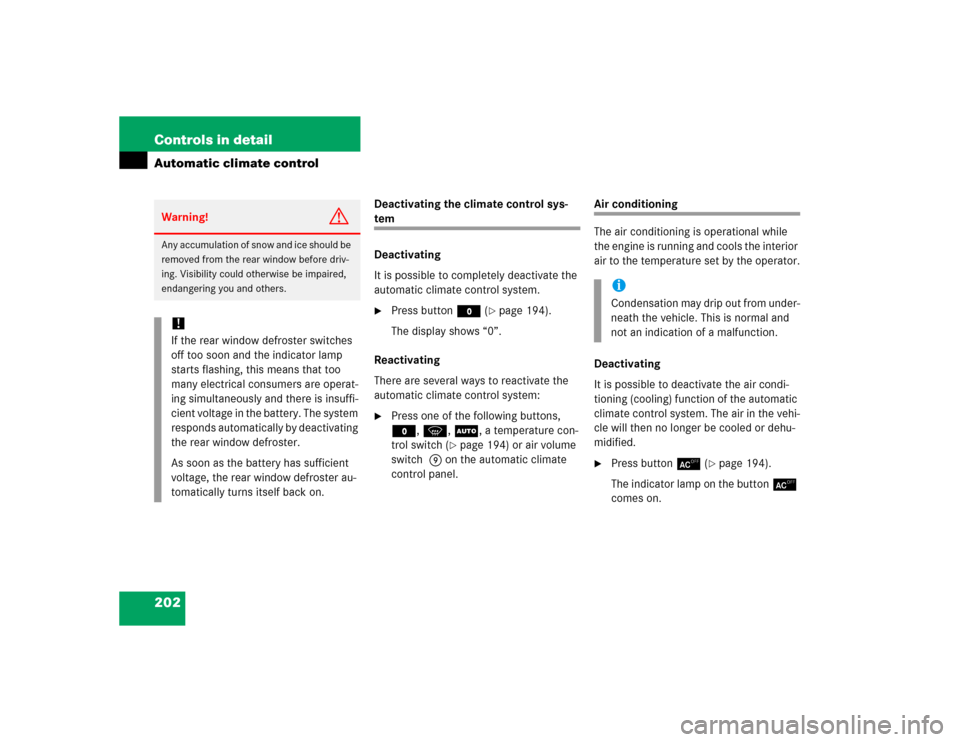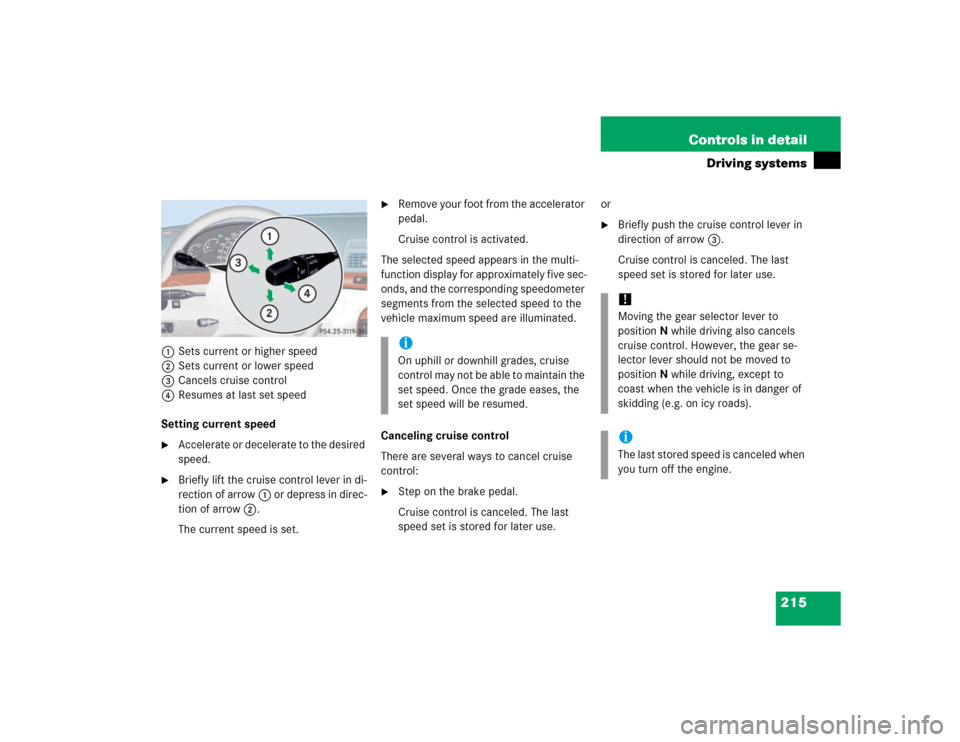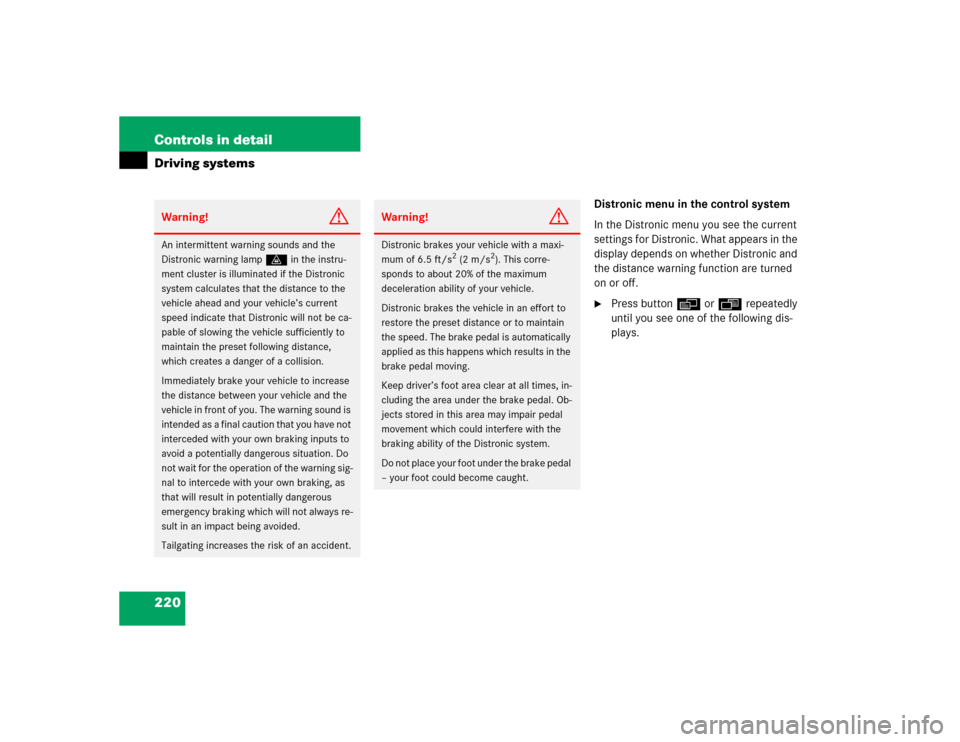Page 200 of 474
198 Controls in detailAutomatic climate controlAdjusting air volume
Use air volume control9 (
�page 194) for
both automatic and manual air volume ad-
justment.
Adjusting automatically
�
PressA on air volume switch9
(�page 194).
The display shows “AUTO.” The air vol-
ume is adjusted automatically.Adjusting manually
Reducing air volume
�
Press switch9 down until the desired
air volume is reached.
The display shows the current level.
Increasing air volume
�
Press switch9 up until the desired air
volume is reached.
The display shows the current level.
Maximum cooling MAXCOOL
If the left and right air distribution controls
as well as the air volume control are set
toU and there is a high need for cool-
ing, the display “AUTO MAXCOOL” ap-
pears.
This provides the fastest possible cooling
of the vehicle interior (when windows and
tilt/sliding sunroof are closed).
Page 204 of 474

202 Controls in detailAutomatic climate control
Deactivating the climate control sys-tem
Deactivating
It is possible to completely deactivate the
automatic climate control system. �
Press button M (
�page 194).
The display shows “0”.
Reactivating
There are several ways to reactivate the
automatic climate control system:
�
Press one of the following buttons,
M, P, U, a temperature con-
trol switch (
�page 194) or air volume
switch 9 on the automatic climate
control panel.
Air conditioning
The air conditioning is operational while
the engine is running and cools the interior
air to the temperature set by the operator.
Deactivating
It is possible to deactivate the air condi-
tioning (cooling) function of the automatic
climate control system. The air in the vehi-
cle will then no longer be cooled or dehu-
midified.�
Press button± (
�page 194).
The indicator lamp on the button±
comes on.
Warning!
G
Any accumulation of snow and ice should be
removed from the rear window before driv-
ing. Visibility could otherwise be impaired,
endangering you and others.!If the rear window defroster switches
off too soon and the indicator lamp
starts flashing, this means that too
many electrical consumers are operat-
ing simultaneously and there is insuffi-
cient voltage in the battery. The system
responds automatically by deactivating
the rear window defroster.
As soon as the battery has sufficient
voltage, the rear window defroster au-
tomatically turns itself back on.
iCondensation may drip out from under-
neath the vehicle. This is normal and
not an indication of a malfunction.
Page 208 of 474
206 Controls in detailAutomatic climate controlRear automatic climate control panel
iWhen the rear seats are not occupied
(rear seat belts unbuckled) the rear cli-
mate control system adopts the set-
tings of the front climate control
system.
Item
1
Left center air vent, adjustable
2
Display
3
Right center air vent, adjustable
4
Thumbwheel for air distribution
5
Temperature control, right
6
Air volume (automatic, manual)
7
Temperature control, left
8
Rear climate control system on/off
Residual engine heat utilization
Warning!
G
Follow the recommended settings for heat-
ing and cooling as given in the instructions
for the front automatic climate control
(�page 192). Otherwise the windows could
fog up, impairing visibility for the driver and
endangering you and others.
Page 217 of 474

215 Controls in detail
Driving systems
1Sets current or higher speed
2Sets current or lower speed
3Cancels cruise control
4Resumes at last set speed
Setting current speed�
Accelerate or decelerate to the desired
speed.
�
Briefly lift the cruise control lever in di-
rection of arrow1 or depress in direc-
tion of arrow2.
The current speed is set.
�
Remove your foot from the accelerator
pedal.
Cruise control is activated.
The selected speed appears in the multi-
function display for approximately five sec-
onds, and the corresponding speedometer
segments from the selected speed to the
vehicle maximum speed are illuminated.
Canceling cruise control
There are several ways to cancel cruise
control:
�
Step on the brake pedal.
Cruise control is canceled. The last
speed set is stored for later use.or
�
Briefly push the cruise control lever in
direction of arrow3.
Cruise control is canceled. The last
speed set is stored for later use.
iOn uphill or downhill grades, cruise
control may not be able to maintain the
set speed. Once the grade eases, the
set speed will be resumed.
!Moving the gear selector lever to
positionN while driving also cancels
cruise control. However, the gear se-
lector lever should not be moved to
positionN while driving, except to
coast when the vehicle is in danger of
skidding (e.g. on icy roads).iThe last stored speed is canceled when
you turn off the engine.
Page 218 of 474

216 Controls in detailDriving systemsSetting a higher speed�
Lift cruise control lever in direction of
arrow1 and hold it up until the de-
sired speed is reached.
�
Release cruise control lever.
The new speed is set.
Setting a lower speed
�
Depress cruise control lever in direc-
tion of arrow2 and hold it down until
the desired speed is reached.
�
Release cruise control lever.
The new speed is set.Fine adjustment in 1 mph
(Canada: 1 km/h) increments
Faster
�
Briefly tip cruise control lever in direc-
tion of arrow1.
Slower
�
Briefly tip cruise control lever in direc-
tion of arrow2.Setting to last stored speed
(“Resume” function)
�
Briefly push cruise control lever in di-
rection of arrow4.
The cruise control resumes the last set
speed.
�
Remove your foot from the accelerator
pedal.
The selected speed appears in the multi-
function display for approximately five sec-
onds, and the corresponding speedometer
segments from the selected speed to the
vehicle maximum speed are illuminated.
iDepressing the accelerator pedal does
not deactivate cruise control. After
brief acceleration (e.g. for passing),
cruise control will resume the last
speed set.
iWhen you use the cruise control lever
to decelerate, the transmission will au-
tomatically downshift if the engine’s
braking power does not brake the vehi-
cle sufficiently.
Warning!
G
The speed stored in memory should only be
set again if prevailing road conditions per-
mit. Possible acceleration or deceleration
differences arising from returning to the pre-
set speed could cause an accident and/or
serious injury to you and others.
Page 221 of 474
219 Controls in detail
Driving systems
Distronic displays in the speedometer
dialSet speedIf Distronic is activated, one or two seg-
ments come on around the set speed.
SegmentsIf Distronic detects a vehicle directly
ahead, the segments from the speed of the
vehicle ahead to the set speed come on.
If Distronic calculates that there is a dan-
ger of collision (
�page 225):
�
The red Distronic warning lampl in
the instrument cluster comes on.
�
An intermittent warning sounds.
�
Immediately brake the vehicle to avoid
a collision.
Under no circumstances should the
driver await the intermittent warning
sound before braking. See the follow-
ing warning note.
The intermittent warning sound ceases
and the red Distronic warning
lampl goes out when the neces-
sary distance to the vehicle ahead is
again established.
iThe vehicle speed displayed on the
speedometer can briefly vary from the
speed setting on the Distronic system.
Page 222 of 474

220 Controls in detailDriving systems
Distronic menu in the control system
In the Distronic menu you see the current
settings for Distronic. What appears in the
display depends on whether Distronic and
the distance warning function are turned
on or off.�
Press buttonè orÿ repeatedly
until you see one of the following dis-
plays.
Warning!
G
An intermittent warning sounds and the
Distronic warning lampl in the instru-
ment cluster is illuminated if the Distronic
system calculates that the distance to the
vehicle ahead and your vehicle’s current
speed indicate that Distronic will not be ca-
pable of slowing the vehicle sufficiently to
maintain the preset following distance,
which creates a danger of a collision.
Immediately brake your vehicle to increase
the distance between your vehicle and the
vehicle in front of you. The warning sound is
intended as a final caution that you have not
interceded with your own braking inputs to
avoid a potentially dangerous situation. Do
not wait for the operation of the warning sig-
nal to intercede with your own braking, as
that will result in potentially dangerous
emergency braking which will not always re-
sult in an impact being avoided.
Tailgating increases the risk of an accident.
Warning!
G
Distronic brakes your vehicle with a maxi-
mum of 6.5 ft/s
2 (2 m/s
2). This corre-
sponds to about 20% of the maximum
deceleration ability of your vehicle.
Distronic brakes the vehicle in an effort to
restore the preset distance or to maintain
the speed. The brake pedal is automatically
applied as this happens which results in the
brake pedal moving.
Keep driver’s foot area clear at all times, in-
cluding the area under the brake pedal. Ob-
jects stored in this area may impair pedal
movement which could interfere with the
braking ability of the Distronic system.
Do not place your foot under the brake pedal
– your foot could become caught.
Page 223 of 474
221 Controls in detail
Driving systems
Distronic deactivated
If Distronic is deactivated, the standard
display of Distronic appears in the multi-
function display.
1Vehicle ahead, if detected
2Actual distance to vehicle ahead
3Preset distance threshold to vehicle
ahead
4Symbol for activated distance warning
function
5Your vehicleDistronic activated
When you turn Distronic on, you will see
the set speed in the multifunction display
for about five seconds. You then see the
following display in the multifunction dis-
play.
1Distronic activatedCruise control lever
The Distronic system is operated by means
of the cruise control lever.
The cruise control lever is the uppermost
lever on the left-hand side of the steering
column.
1Sets current or higher speed
2Sets current or lower speed
3Deactivates Distronic
4Resumes at last set speed